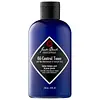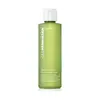What's inside
What's inside
 Key Ingredients
Key Ingredients

 Benefits
Benefits

 Concerns
Concerns

 Ingredients Side-by-side
Ingredients Side-by-side

Water
Skin ConditioningHamamelis Virginiana Water
AstringentButylene Glycol
HumectantPolysorbate 20
EmulsifyingPropanediol
SolventLactic Acid
BufferingSalicylic Acid
MaskingGlycerin
HumectantMenthyl Lactate
MaskingGeranium Maculatum Oil
MaskingRosmarinus Officinalis Leaf Oil
MaskingMoringa Oleifera Seed Extract
Skin ConditioningBetula Alba Juice
AstringentHydrolyzed Rhodophyceae Extract
Saccharomyces Ferment Filtrate
HumectantIris Germanica Florentina Root Extract
PerfumingLeuconostoc Ferment Filtrate
AntimicrobialSodium Hyaluronate
HumectantAnthemis Nobilis Flower Oil
MaskingAloe Barbadensis Leaf Extract
EmollientAnthemis Nobilis Flower Extract
MaskingCucumis Sativus Fruit Extract
EmollientPanax Ginseng Root Extract
EmollientBiotin
AntiseborrhoeicRetinyl Palmitate
Skin ConditioningTocopheryl Acetate
AntioxidantSodium Citrate
BufferingCitric Acid
BufferingSodium Benzoate
MaskingPotassium Sorbate
PreservativeBenzoic Acid
MaskingOleth-20
CleansingCaprylic/Capric Triglyceride
MaskingDisodium EDTA
Zinc PCA
HumectantPhenoxyethanol
PreservativeWater, Hamamelis Virginiana Water, Butylene Glycol, Polysorbate 20, Propanediol, Lactic Acid, Salicylic Acid, Glycerin, Menthyl Lactate, Geranium Maculatum Oil, Rosmarinus Officinalis Leaf Oil, Moringa Oleifera Seed Extract, Betula Alba Juice, Hydrolyzed Rhodophyceae Extract, Saccharomyces Ferment Filtrate, Iris Germanica Florentina Root Extract, Leuconostoc Ferment Filtrate, Sodium Hyaluronate, Anthemis Nobilis Flower Oil, Aloe Barbadensis Leaf Extract, Anthemis Nobilis Flower Extract, Cucumis Sativus Fruit Extract, Panax Ginseng Root Extract, Biotin, Retinyl Palmitate, Tocopheryl Acetate, Sodium Citrate, Citric Acid, Sodium Benzoate, Potassium Sorbate, Benzoic Acid, Oleth-20, Caprylic/Capric Triglyceride, Disodium EDTA, Zinc PCA, Phenoxyethanol
Water
Skin ConditioningPolysorbate 20
EmulsifyingHamamelis Virginiana Water
AstringentGlycerin
HumectantGluconolactone
Skin ConditioningGlycolic Acid
BufferingLactic Acid
BufferingOleth-20
CleansingSalicylic Acid
MaskingSodium Hydroxide
BufferingSodium Benzoate
MaskingMenthyl Lactate
MaskingEucalyptus Globulus Leaf Oil
PerfumingMentha Piperita Oil
MaskingMelia Azadirachta Seed Oil
EmollientLinoleic Acid
CleansingMacrocystis Pyrifera Extract
Skin ConditioningEucalyptus Globulus Leaf Extract
PerfumingChondrus Crispus Extract
Skin ConditioningCamellia Sinensis Leaf Extract
AntimicrobialLinolenic Acid
CleansingPhenoxyethanol
PreservativeCalcium Gluconate
HumectantBenzoic Acid
MaskingTocopherol
AntioxidantLimonene
PerfumingWater, Polysorbate 20, Hamamelis Virginiana Water, Glycerin, Gluconolactone, Glycolic Acid, Lactic Acid, Oleth-20, Salicylic Acid, Sodium Hydroxide, Sodium Benzoate, Menthyl Lactate, Eucalyptus Globulus Leaf Oil, Mentha Piperita Oil, Melia Azadirachta Seed Oil, Linoleic Acid, Macrocystis Pyrifera Extract, Eucalyptus Globulus Leaf Extract, Chondrus Crispus Extract, Camellia Sinensis Leaf Extract, Linolenic Acid, Phenoxyethanol, Calcium Gluconate, Benzoic Acid, Tocopherol, Limonene
Ingredients Explained
These ingredients are found in both products.
Ingredients higher up in an ingredient list are typically present in a larger amount.
Benzoic Acid is used to preserve and adjust the pH of products.
The antimicrobial property of Benzoic Acid helps elongate a product's shelf life. Its main role is to reduce fungi growth and is not found to be effective at fighting bacteria. Therefore Benzoic Acid is always added along with other preservatives.
In its pure form, Benzoic Acid looks like a white crystalline solid. It has slight solubility in water.
The name of Benzoic Acid comes from gum benzoin, which used to be the sole source of deriving this ingredient. Benzoic Acid is the most simple aromatic carboxylic acid.
Benzoic Acid is naturally occuring in strawberries, mustard, cinnamon, and cloves. It has a slight scent but is not considered to be a fragrance.
Learn more about Benzoic AcidGlycerin is already naturally found in your skin. It helps moisturize and protect your skin.
A study from 2016 found glycerin to be more effective as a humectant than AHAs and hyaluronic acid.
As a humectant, it helps the skin stay hydrated by pulling moisture to your skin. The low molecular weight of glycerin allows it to pull moisture into the deeper layers of your skin.
Hydrated skin improves your skin barrier; Your skin barrier helps protect against irritants and bacteria.
Glycerin has also been found to have antimicrobial and antiviral properties. Due to these properties, glycerin is often used in wound and burn treatments.
In cosmetics, glycerin is usually derived from plants such as soybean or palm. However, it can also be sourced from animals, such as tallow or animal fat.
This ingredient is organic, colorless, odorless, and non-toxic.
Glycerin is the name for this ingredient in American English. British English uses Glycerol/Glycerine.
Learn more about GlycerinHamamelis Virginiana Water is made by distilling parts of the witch hazel plant. You can also call this ingredient "witch hazel water".
The name 'Hamamelis Virginiana Water' refers to the distillation product used in cosmetics. On the other hand, 'Witch Hazel' refers to the active drug ingredient.
Unless it is specified to be non-alcohol, many types of witch hazel ingredients are distilled in denatured alcohol.
Witch Hazel water is an astringent, anti-inflammatory antioxidant, and antibacterial ingredient.
It contains tannins. Tannins have a drying effect when used on skin by constricting proteins. The constriction also minimizes the appearance of pores.
Both the tannins and fragrance found in witch hazel may be skin-sensitizing.
Witch hazel water gets anti-inflammatory and antibacterial properties from its catechin and gallic acid content.
Indigenous groups have used witch hazel to help treat inflammation in North America for centuries.
Learn more about Hamamelis Virginiana WaterLactic Acid is another well-loved alpha hydroxy acid (AHA). It is gentler than glycolic acid but still highly effective.
Its main role is to exfoliate the surface of the skin by loosening the “glue” that holds dead skin cells together. Shedding those old cells leads to smoother, softer, and more even-toned skin.
Because lactic acid molecules are larger than glycolic acid, they don’t penetrate as deeply. This means they’re less likely to sting or irritate, making it a great choice for beginners or those with sensitive skin.
Like glycolic acid, it can:
Lactic acid also acts as a humectant (like hyaluronic acid). It can draw water into the skin to improve hydration and also plays a role in the skin's natural moisturizing factor (NMF) in the form of sodium lactate.
Studies show it can boost ceramide production to strengthen the skin barrier and even help balance the skin’s microbiome.
To get results, choose products with a pH between 3-4.
Lower strengths (5-12%) focus on surface exfoliation; higher strengths (12% and up) can reach deeper in the dermis (deeper, supportive layer) to improve skin texture and firmness over time.
Though it was originally derived from milk, most modern lactic acid used in skincare is vegan. It is made through non-dairy fermentation to create a bio-identical and stable form suitable for all formulations.
When lactic acid shows up near the end of an ingredient list, it usually means the brand added just a tiny amount to adjust the product’s pH.
Legend has it that Cleopatra used to bathe in sour milk to help reduce wrinkles.
Lactic acid is truly a gentle multitasker: it exfoliates, hydrates, strengthens, and brightens. It's a great ingredient for giving your skin a smooth, glowing, and healthy look without the harshness of stronger acids.
Read more about some other popular AHA's here:
Learn more about Lactic AcidMenthyl lactate is an ester of menthol and lactic acid. It is often used as a cooling agent and fragrance.
When applied topically, this ingredient leaves a refreshing sensation like menthol, but is less irritating.
Oleth-20 comes from oleyl alcohol. It is an emulsifier that helps reduce surface tension of dirt and pollutants to be washed away.
The 20 stands for the average number of ethylene oxide units.
Phenoxyethanol is a preservative that has germicide, antimicrobial, and aromatic properties. Studies show that phenoxyethanol can prevent microbial growth. By itself, it has a scent that is similar to that of a rose.
It's often used in formulations along with Caprylyl Glycol to preserve the shelf life of products.
Polysorbate 20 is made by combining ethoxylation of sorbitan, ethylene oxide, and lauric acid. It is a mild cleansing agent, surfactant, and emulsifier.
As a surfactant, it helps collect dirt and oils for washing. Emulsifiers prevent oils and water from separating.
Polysorbate 20 also adds scent to a product. Since it is made using sorbitol, it has a sweet scent. Sorbitol can also be found in fruits such as apples and peaches.
The lauric acid used to create Polysorbate 20 is often derived from coconuts.
Polysorbate 20 may not be fungal acne safe.
Learn more about Polysorbate 20Salicylic Acid (also known as beta hydroxy acid or BHA) is a well-known ingredient for treating skin that struggles with acne and clogged pores. It exfoliates both the skin's surface and deep within the pores to help clear out buildup, control oil, and reduce inflammation.
Unlike AHAs (alpha hydroxy acids), salicylic acid is oil-soluble. This allows it to penetrate into pores which makes it especially effective for treating blackheads and preventing future breakouts.
Salicylic acid is also known for its soothing properties. It has a similar structure to aspirin and can calm inflamed or irritated skin, making it a good option for acne-prone skin that is also sensitive.
Concentrations of 0.5-2% are recognized by the U.S. FDA as an over-the-counter topical acne product.
It can cause irritation and/or dryness if one's skin already has a compromised moisture barrier, so it's best to focus on repairing that before introducing this ingredient into your routine.
While salicylic acid does not increase sun sensitivity, it’s still important to wear sunscreen daily to protect your skin.
If you are looking for the ingredient called BHA or Butylated Hydroxyanisole, click here.
Learn more about Salicylic AcidSodium Benzoate is a preservative. It's used in both cosmetic and food products to inhibit the growth of mold and bacteria. It is typically produced synthetically.
Both the US FDA and EU Health Committee have approved the use of sodium benzoate. In the US, levels of 0.1% (of the total product) are allowed.
Sodium benzoate works as a preservative by inhibiting the growth of bacteria inside of cells. It prevents the cell from fermenting a type of sugar using an enzyme called phosphofructokinase.
It is the salt of benzoic acid. Foods containing sodium benzoate include soda, salad dressings, condiments, fruit juices, wines, and snack foods.
Studies for using ascorbic acid and sodium benzoate in cosmetics are lacking, especially in skincare routines with multiple steps.
We always recommend speaking with a professional, such as a dermatologist, if you have any concerns.
Learn more about Sodium BenzoateWater. It's the most common cosmetic ingredient of all. You'll usually see it at the top of ingredient lists, meaning that it makes up the largest part of the product.
So why is it so popular? Water most often acts as a solvent - this means that it helps dissolve other ingredients into the formulation.
You'll also recognize water as that liquid we all need to stay alive. If you see this, drink a glass of water. Stay hydrated!
Learn more about Water